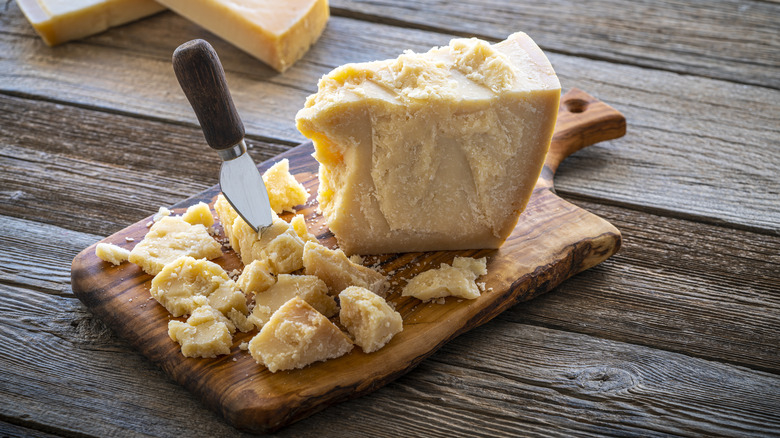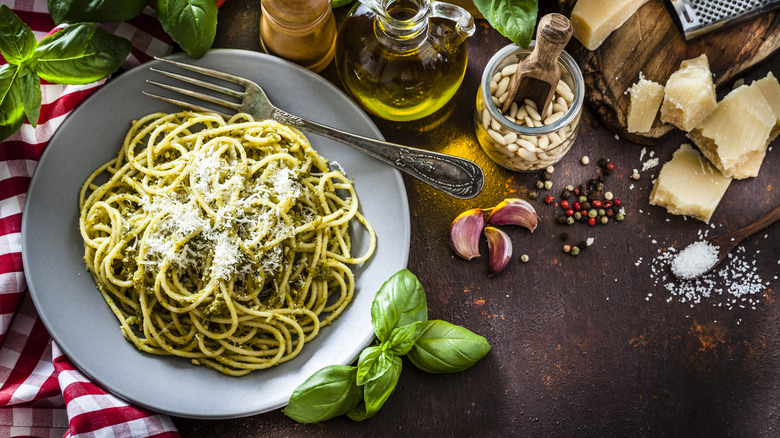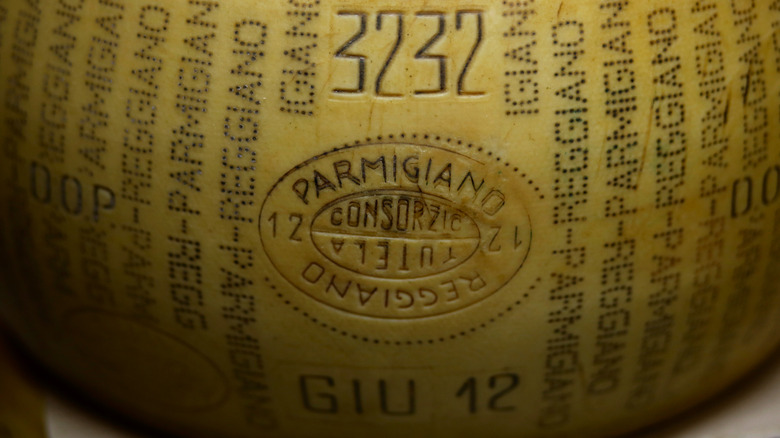Parmesan And Parmigiano-Reggiano Cheese Are Not The Same Thing
Parmesan is widely (and very wrongly) presumed to be nothing but the English translation of the Italian word that is Parmigiano-Reggiano — both used to describe the same sharp, tart, sweet, nutty, and gritty wheel of cheese that is shaved onto steaming plates of pasta in generous abundance. But just like the difference between Pecorino-Romano and parmesan isn't linguistic, neither is the difference between parmesan and Parmigiano-Reggiano simply a name.
Parmigiano-Reggiano is protected under the Denominazione d' Origine Protetta — Protected Designation of Origin (PDO) status. For a cheese to be called Parmigiano-Reggiano, it must follow certain regulations. For one, the cheese is only produced in Italy's Modena, Bologna, Parma, Mantua, or Reggio Emilia regions. Even then, the cheese should be made with just three ingredients — milk, calf rennet, and salt — and must be aged for at least a year. The milk used to make Parmigiano-Reggiano must come from cows that graze in the designated region as it is the characteristics of these green pastures that eventually give the cheese its distinct nutty and fruity flavor. Once the guidelines are met, a regulatory body called the Consorzio checks each wheel of cheese before stamping it with the Parmigiano-Reggiano label.
The term parmesan, on the other hand, is much loser and neither its name, method of production, nor region of production are protected by any means. Parmesan can be produced anywhere in the world, and though it mimics Parmigiano-Reggiano in a way, there are no regulations that standardize its quality.
The problem with parmesan
According to the FDA, as long as a cheese has an easy-to-grate granular texture with a hard and brittle rind, it doesn't matter where it comes from: It can be called parmesan in the United States. While there are broad specifications for how it must be produced, the regulations are few and far between. Parmigiano-Reggiano's 12-month aging period is scrapped down to 10, and any cow's milk flies: It could be cream, skim milk, or even nonfat dry milk reconstituted with water as long as it contains at least 32% milk fat.
With a lack of strict regulations akin to those that guide the production of Parmigiano-Reggiano, parmesan is plagued with the problem of adulteration and counterfeiting. The FDA themselves found that what is sold as pure parmesan often has everything in it but actual parmesan — including things like cellulose, potato starch, and imitation cheese.
While the FDA does allow the use of 2% to 4% of cellulose in parmesan — as opposed to Parmigiano-Reggiano, which bans the use of any additives — a 2012 investigation into Castle Cheese revealed all sorts of fillers inside its "100% real parmesan," including cellulose and other cheeses such as mozzarella, swiss, and cheddar (per CBS News). In fact, the scope of the problem of fake parmesan is such that the Parmigiano Reggiano Consortium estimates nearly $2 billion worth of counterfeit parmesan is sold each year — a figure that is awfully close to the annual sales of Parmigiano-Reggiano.
How to tell Parmigiano-Reggiano from parmesan
The difference between parmesan and Parmigiano-Reggiano is all good info to tuck away at the back of your brain, but it won't matter if you don't know how to tell one from the other when you're out shopping for the cheese. The good thing about Parmigiano-Reggiano's PDO status is that it has certain official marks that parmesan does not. Each wheel must have the words "Parmigiano-Reggiano" dotted onto the edible rind as well as its month or year of production. Even when a cheesemonger does slice a wheel into smaller wedges, regulations state that each wedge must feature at least a part of the dotted wording. Each wheel will also have the oval "Consorzio Tutela Parmigiano Reggiano" stamp that's granted by the Consorzio after it successfully passes inspection.
Even pre-wedged or pre-grated and packaged Parmigiano-Reggiano must carry certain official stamps, including the authorization number granted by the Consorzio, an EU PDO symbol, and a certification statement from the Italian Authority. When in doubt, however, always look for the words Parmigiano-Reggiano — any spelling errors, abbreviations, or condensed version of the official name is almost always a giveaway of counterfeit parmesan hiding in disguise. Plus, Parmigiano-Reggiano's PDO status and extensive production process means that it tends to have a higher price tag, so be wary if you're getting a suspiciously good bargain. Being on the lookout for these telltale signs will help you distinguish parmesan from the king of cheeses that is Parmigiano-Reggiano!



